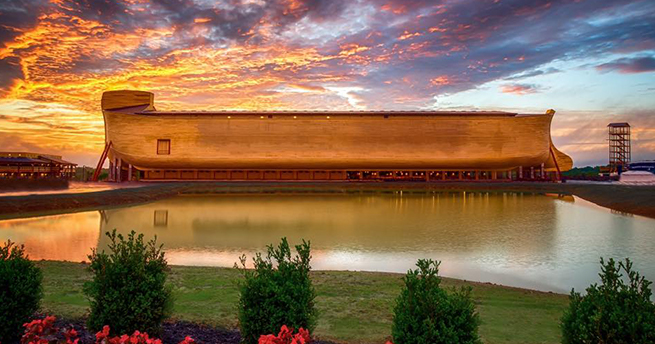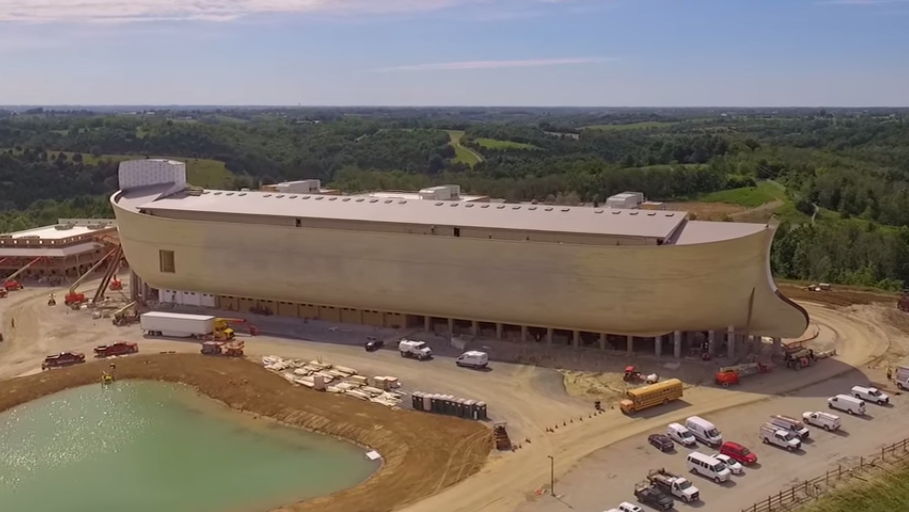Oh yes, it’s finally here: Ken Ham’s imagining of what Noah’s Ark “really” looked like is open to the public. But what does that mean?
***
14. Make yourself a teba of gofer; make rooms in the teba, and cover it inside and out with pitch.
15. This is how you are to make it: the length of the teba three hundred cubits, its width fifty cubits, and its height thirty cubits.
16. Make a tsohar for the teba, and finish it to a cubit above; and put the door of the teba in its side; make it with lower, second, and third decks.
So reads Genesis 6:14-16 in the NRSV, with a couple of tweaks added by yours truly. The tweaks are the words “gofer,” “tsohar,” and “teba,” which I’ve left in badly transliterated Hebrew for now (I’ll explain below). This is the sum total of all the instructions (apparently) that Noah was given before the near-genocide of every species on earth by the kind and loving god of Abraham.
Now, let’s set aside the myriad issues with this story: that it’s probably just a bigger fish version of the Babylonian flood myth from Gilgamesh; that the Earth was supposedly repopulated by seven people and not the 50-500 necessary for a healthy population; the serious geological inconsistencies in the young earth creationist model; the question of why god felt it necessary to kill all the animals if they weren’t sinful (couldn’t he have just sent a human-specific plague?); and on and on and on.
Instead let’s just look at the claim that this version of the ark is the Biblical one. It is according to this not exactly specific blueprint that our buddy Ken decided to build his $100-million-plus dollar tourist attraction devotional aid. There are some real questions, and he’s really put a surprising amount of thought into them. The only issues I have are, as usual, both his circular logic — a fallacy in which we know the conclusion and therefore we can derive the premises — and his tendency to use terms like “more likely” and “unmistakable” when he really means “more in line with what I want to think.”
So take the size: the Ark of Ham measures 510 feet long. If it’s 300 cubits, that means they’re following the Sumerian Cubit (20.4″) rather than the Biblical Cubit (18″), the Egyptian Cubit (20.6-20.8″), or the Ancient Roman Cubit (18.5″). [Note: he thinks he’s using a Hebrew Cubit, but like most of his ideas, I’m not entirely sure where they originate because he rarely ever cites things]. Otherwise you get a boat that’s somewhere from 450 feet to 520 feet long. That’s because a “cubit” is (we think) roughly equivalent to the length from a man’s elbow to his wrist, and men come in various sizes. We don’t know for sure. But at least he kinda-sorta admits this.
But what about the rest of the design?
As you can see from these photos (taken from ArkEncounter.com where you may see more for yourself at your leisure) the Ark of Ham has a roof with skylights, and is made from wood. None of these should be taken for granted. The material Noah was told to make the ark out of was gofer, a hapax legomenon (a word that appears nowhere else). This means that we don’t actually know what it was, though it could have been kopher, or “pitch” — meaning simply “pitched wood” — or something derived from the Assyrian word giparu, meaning “reeds.” Frankly, the only other time the word “ark” is used in the Bible (the Hebrew word is teba) is describing the basket of rushes that Moses floats downriver in, so reeds isn’t exactly outlandish. The roof, tsohar, is another mystery. It’s been interpreted to mean roof, but it’s also been interpreted to mean window, or maybe a row of windows going all around the side. The Ark of Ham has a keel, and a distinctive prow and stern too — but those aren’t in the instructions either.
The boat is modern-day cargo-ship-shaped because a block-shaped one (as described in the (sorry Ken) definitely earlier Epic of Gilgamesh) would have been “dangerously unstable.” It’s wood and not a big reed basket because it’s “more likely” that teba meant “lifeboat” than “basket.” The strange shape is supposed to be a wind-driven design to steer the ship into the waves, so it doesn’t capsize. The logic there again is simple: the boat didn’t capsize, but it was almost certainly windy and therefore wavy on a global ocean, so it must’ve had a way not to. Remember what I was saying about assuming the conclusion?
What you end up with is an exercise in circular self-reinforcement: it’s shaped like a boat because it couldn’t have survived shaped any other way, and of course it survived because it’s definitely a 100% true story that totally happened exactly the way it says in the Bible.
And this is the thing I really don’t get about the Answers In Genesis people. If you’re going to assume, without proof, the existence of a whole bunch of scientifically unjustifiable supernatural phenomena — not just god, but miracles, angels, the ability to create a world in six days — then why bother with science at all? Why try to come up with a logic-based system of belief when your first premises are without logic in the first place? Why not just say “it doesn’t matter what shape the boat was because god made sure it wouldn’t tip over”? He could have just used whatever physics he used to create (and then magically un-create) enough water to cover every inch of the globe.
Anyway, it’s a pretty amazing sight, and if I weren’t afraid of the other people that would go see it, it might even be worth paying the $40 entrance fee, the way you go see the Biggest Ball of Twine or the World’s Largest Frying Pan. I kind-of wish the US taxpayers hadn’t helped out with its construction to the tune of an $18 million tax credit, but then, I also wish that religious organizations wouldn’t get any of the $82.5 billion in tax credits the US taxpayer forks over every year.
Ken Ham made a very large, very expensive, and very boat-like boat. He’s calling it a model of Noah’s Ark, and for all the grounding in reality the term has, it may as well be. Just don’t ask me or anyone else to spend 370 days aboard it with two each of millions of species of animals, because to survive that would take — well, if we’re being honest, it’d take a miracle.
***
Thanks for reading! I only get paid in my own (and your) enthusiasm, so please like This Week In Tomorrow on Facebook, follow me on Twitter @TWITomorrow, and tell your friends about the site!
If you like our posts and want to support our site, please share it with others, on Facebook, Twitter, Reddit — anywhere you think people might want to read what we’ve written. Thanks so much for reading, and have a great week.
***
Richard Ford Burley is a human, writer, and doctoral candidate at Boston College, as well as an editor at Ledger, the first academic journal devoted to Bitcoin and other cryptocurrencies. In his spare time he writes about science, skepticism, feminism, and futurism here at This Week In Tomorrow.




